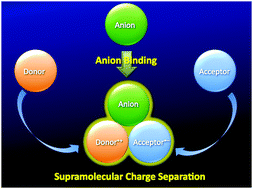Supramolecular electron transfer by anion binding
Abstract
Anion binding has emerged as an attractive strategy to construct supramolecular

* Corresponding authors
a
Department of Material and Life Science, Graduate School of Engineering, Osaka University, ALCA, Japan Science and Technology Agency (JST), Suita, Osaka 565-0871, Japan
E-mail:
fukuzumi@chem.eng.osaka-u.ac.jp
Fax: +81 6 6879 7370
Tel: +81 6 6879 7368
b Department of Bioinspired Science, Ewha Womans University, Seoul 120-750, Korea
c
Department of Chemistry, University of North Texas, 1155 Union Circle, #305070, Denton, USA
E-mail:
francis.dsouza@unt.edu
d
Department of Chemistry & Biochemistry, 1 University Station-A5300, The University of Texas, Austin, USA
E-mail:
sessler@mail.utexas.edu
e Department of Chemistry, Yonsei University, Seoul, Korea
Anion binding has emerged as an attractive strategy to construct supramolecular

 Please wait while we load your content...
Something went wrong. Try again?
Please wait while we load your content...
Something went wrong. Try again?
S. Fukuzumi, K. Ohkubo, F. D'Souza and J. L. Sessler, Chem. Commun., 2012, 48, 9801 DOI: 10.1039/C2CC32848H
To request permission to reproduce material from this article, please go to the Copyright Clearance Center request page.
If you are an author contributing to an RSC publication, you do not need to request permission provided correct acknowledgement is given.
If you are the author of this article, you do not need to request permission to reproduce figures and diagrams provided correct acknowledgement is given. If you want to reproduce the whole article in a third-party publication (excluding your thesis/dissertation for which permission is not required) please go to the Copyright Clearance Center request page.
Read more about how to correctly acknowledge RSC content.
 Fetching data from CrossRef.
Fetching data from CrossRef.
This may take some time to load.
Loading related content
